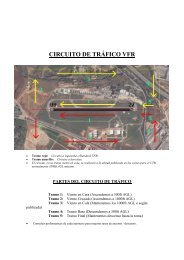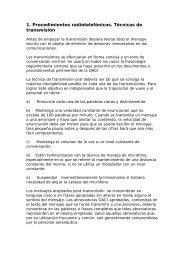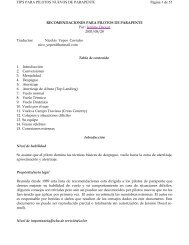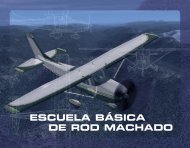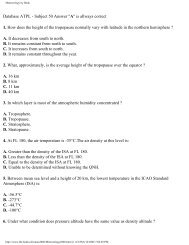ABOUT WINGLETS - Ultraligero.Net
ABOUT WINGLETS - Ultraligero.Net
ABOUT WINGLETS - Ultraligero.Net
You also want an ePaper? Increase the reach of your titles
YUMPU automatically turns print PDFs into web optimized ePapers that Google loves.
suppose you never fly slower than 70 knots.<br />
At this speed, the winglets improve your<br />
sink rate by almost 4 ft/min. You would<br />
need to fly 118 knots in order for the winglet<br />
penalty to be 4 ft/min, negating the benefit.<br />
About the only situation where soaring<br />
speed is consistently high enough that winglets<br />
would actually hurt overall is ridge running.<br />
Even in ridge soaring, there may be<br />
long gaps to cross where the benefit of the<br />
winglets would offset any cruise penalty.<br />
Can the same argument be applied<br />
to tip extensions?<br />
Well, that depends on the structural limitations<br />
on the sailplane. First of all, for<br />
the same improvement in induced drag, a<br />
shorter span extension will be required<br />
(about half, right?) but the tip extension has<br />
more wetted area, so more parasite drag.<br />
This added area is needed to prevent the tip<br />
extension from stalling at low speed. The<br />
reason winglets don’t need the same area<br />
to prevent stalling will be explained later.<br />
Anyway, a tip extension equivalent to the<br />
winglet example might improve induced<br />
drag 11%, but add 2% in parasite drag. At<br />
the best L/D speed: .5 x .11 – .5 x .02 =<br />
.045 (once again). But there is a crucial<br />
assumption hidden in these examples. The<br />
comparison is made at constant weight. If<br />
you install your tip extensions, are you allowed<br />
to ballast the sailplane to the same<br />
weight? If so, then the example is still valid.<br />
Now compare the performance of this tip<br />
extension at 1.73 times the best L/D speed,<br />
where parasite drag is 90% of the total, and<br />
we find: .1 x .11 – .9 x .02 = -.007. So,<br />
now the tip extension that appeared to be<br />
equivalent at low speed degrades high speed<br />
performance 0.7% at the speed where the<br />
winglets still provide a 0.1% benefit. One<br />
way to explain this is to say that the tip<br />
extension reduced the wing loading. What<br />
is really happening is that the parasite drag<br />
was increased for the same weight. What if<br />
you must reduce the gross weight when<br />
you install the tip extensions? In that case,<br />
the tip extensions hurt even more. This<br />
also illustrates why high wing loading is<br />
so important for Open class sailplanes.<br />
The results here depend on many assumptions,<br />
but they do challenge the conventional<br />
wisdom that winglets are not as good<br />
as tip extensions. One major difference<br />
between sailplanes and transport aircraft is<br />
the range of speeds over which they perform.<br />
Transport aircraft adjust their cruising<br />
altitude so that they cruise only slightly faster<br />
than the best L/D speed, but sailplanes are<br />
expected to perform well at almost twice<br />
the best L/D speed.<br />
What about stall? I mentioned that tip<br />
extensions are prone to tip stall, but winglets<br />
are not. Two effects come into play<br />
here. First is that fact that as you scale down<br />
an airfoil, the critical angle of attack for<br />
stall is reduced. This is called a “Reynolds<br />
number effect”. In essence, the basic character<br />
of the flow is affected by the size of<br />
the wing. To achieve the desired elliptical<br />
lift distribution, you would like to make the<br />
tip chord very small, but if the chord is too<br />
small, it will be prone to stall early. So,<br />
now you want to put a tip extension on the<br />
wing, and you still try to achieve that elliptical<br />
lift distribution, but the tip chord must<br />
not get too small. So, you maintain more<br />
surface area and compensate by reducing<br />
the airfoil camber or twisting the wing<br />
slightly to reduce the tip angle of attack.<br />
The added wetted surface area increases<br />
the parasite drag. The second effect explains<br />
why winglets can have such a small chord<br />
(and therefore smaller wetted area) without<br />
stalling. As the sailplane slows down and<br />
the angle of attack increases to maintain<br />
the lift equal to the weight, the tip extension<br />
experiences the same angle of attack<br />
increase, but a winglet does not. The flow<br />
angle experienced by the winglet is determined<br />
by the strength and distribution of<br />
the trailing vorticity, which is indirectly influenced<br />
by the increased angle of attack.<br />
The net result is that the effective increase<br />
in angle of attack for the winglet is much<br />
less than the increase in angle of attack on<br />
the wing. So, the lift doesn’t build up as fast<br />
on the winglet and the wing stalls first. In<br />
practise, this effect is exploited to reduce<br />
the wetted area of the winglet as much as<br />
possible to the point where, ideally, the<br />
wing and winglet would stall at about the<br />
same time.<br />
Other good things about winglets<br />
Aside from the performance improvement<br />
offered by winglets, there are other benefits.<br />
The most notable of these are the<br />
increase in dihedral, increase in aileron<br />
effectiveness, and the reduction of adverse<br />
yaw. The increase in effective dihedral improves<br />
handling in thermals. There is less<br />
need for “top stick” to prevent a spiral dive.<br />
KR-03a “Krosno”<br />
the trainer we’ve all been<br />
waiting for<br />
Ed Hollestelle, 2371 Dundas St. London ON N5V 1R4<br />
(519) 461-1464 phone & fax<br />
103002.722@compuserve.com<br />
The impression is that the aircraft “grooves”<br />
better in a turn. The increase in aileron effectiveness<br />
and the reduction in adverse yaw<br />
both come from the lift of the winglet when<br />
the aileron is deflected. When the aileron is<br />
deflected, there is less “tip loss” of the added<br />
lift. There is much less of an increase in the<br />
tip vortex strength, again because the vorticity<br />
is spread out along the longer trailing<br />
edge, and the tip is further away. As a result,<br />
adverse yaw may be eliminated. For<br />
heavily ballasted sailplanes, the increased<br />
control and safety offered by the winglets<br />
may be a big advantage, regardless of any<br />
improvement in glide performance.<br />
Other bad things about winglets<br />
One disadvantage that is not often discussed<br />
is the reduction in flutter speed. Classical<br />
flutter occurs when the natural frequency<br />
in bending and the natural frequency in<br />
torsion get too close together. The torsion<br />
frequency is always somewhat higher than<br />
the bending frequency. By adding weight<br />
above the plane of the wing, the torsional<br />
moment of inertia is increased, which reduces<br />
the torsion frequency of the wing.<br />
Of course, tip extensions also reduce flutter<br />
speed. Both can be compensated for by<br />
clever addition of balance weights to the<br />
wing, but this is a complex problem requiring<br />
sophisticated analysis.<br />
Conclusion I hope I’ve answered more<br />
questions than I’ve raised. I’m happy to discuss<br />
winglets in more detail with anyone,<br />
feel free to contact me by email at<br />
scsmith@mail.arc.nasa.gov ❖<br />
Steve Smith is a Senior Aerospace Engineer<br />
at the NASA Ames Research Center. A full<br />
discussion of winglet design concepts can<br />
be found in “free flight” 2/92 p6.<br />
• safe and docile handling<br />
• affordable price for clubs<br />
• fantastic cockpit visibility<br />
• advanced corrosion control<br />
and polyurethane finish<br />
• robust metal structure has been<br />
fatigue tested to 18,000 hours<br />
SOLAIRE<br />
CANADA<br />
4/97 free flight 17<br />
KR-03A<br />
Now flying<br />
in Canada!



